
With an aim to support Altair Embed portfolio by adding Shakti processor, Altair Engineering India has announced its collaboration with the IIT Madras.
The Shakti processor is India’s first indigenous RISC-V processor and is the result of an initiative backed by the Ministry of Electronics and Information Technology, Government of India, and Pratap Subrahmanyam Centre for Digital Intelligence and Secure Hardware Architecture. It promotes the indigenous development of products that offer best-in-class security and visibility for users adopting the RISC-V technology.
Altair Embed has been a proven tool for model-based firmware development of embedded systems, including motor control, Internet of Things (IoT) devices, and vision systems. It provides a visual environment to build and validate reliable embedded systems via simulation or hardware-in-the-loop (HIL). In addition, it helps users iterate code faster and improve system efficiency, giving confidence that embedded systems are production-ready.
Shakti processors are industrial-grade systems aimed at embedded applications, robotic controllers, and IoT boards. By supporting this, Altair Embed broadens its presence in developing embedded firmware for internet-connected devices.
The key features in Embed include extensive hardware support, automatic C code generation, combine data flow with UML state chart logic, and availability via Altair units.
“Altair believes that collaboration with academic institutions is a powerful and effective tool to advance technological initiatives. We have been following the open-source RISC V architecture for some time, and it’s exciting to see Dr Kamakoti and IIT Madras make such creative use of it,” said Peter Darnell, Chief Scientist, Altair.
Professor Kamakoti, Department of Computer Science and Engineering, IIT Madras, said, “It was exciting to build an indigenous processor from scratch and more exciting to take it to a production level. It was largely a student-driven effort backed by industry veterans who dedicate themselves to the project never-minding a large pay cut.”
NB: Photo is representational. Courtesy: Shakti.